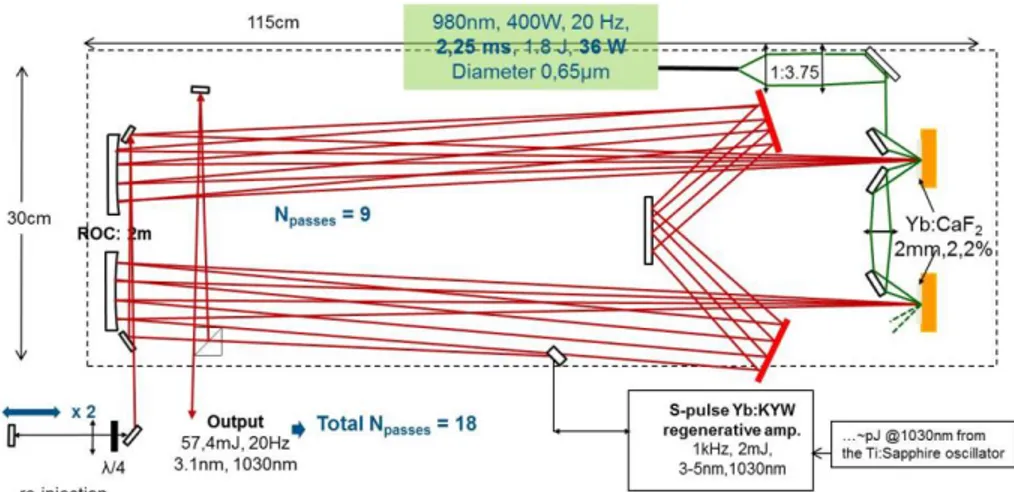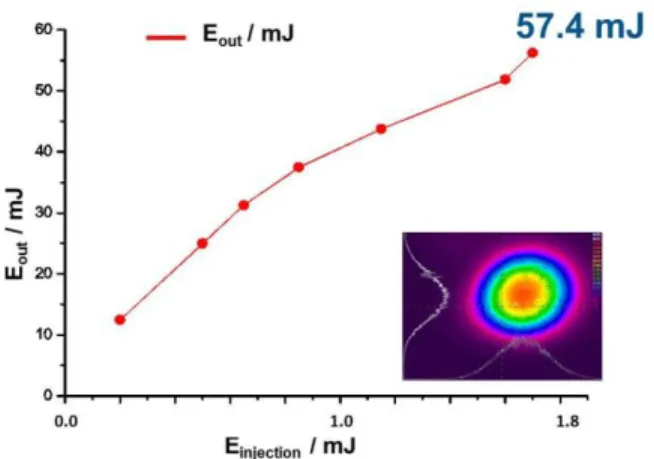HAL Id: hal-01368407
https://hal-iogs.archives-ouvertes.fr/hal-01368407
Submitted on 19 Sep 2016
HAL is a multi-disciplinary open access
archive for the deposit and dissemination of
sci-entific research documents, whether they are
pub-lished or not. The documents may come from
teaching and research institutions in France or
abroad, or from public or private research centers.
L’archive ouverte pluridisciplinaire HAL, est
destinée au dépôt et à la diffusion de documents
scientifiques de niveau recherche, publiés ou non,
émanant des établissements d’enseignement et de
recherche français ou étrangers, des laboratoires
publics ou privés.
57-mJ 20-Hz multipass laser amplifier based on Yb:CaF
2 crystals (orale)
Florence Friebel, Alain Pellegrina, Dimitrios Papadopoulos, Patrice Camy,
Jean-Louis Doualan, Richard Moncorge, Patrick Georges, Frédéric Druon
To cite this version:
Florence Friebel, Alain Pellegrina, Dimitrios Papadopoulos, Patrice Camy, Jean-Louis Doualan, et al..
57-mJ 20-Hz multipass laser amplifier based on Yb:CaF 2 crystals (orale). JNCO (Journées Nationales
des Cristaux pour l’Optique), Jun 2013, Cherbourg, France. �hal-01368407�
57-mJ 20-Hz multipass laser amplifier based on Yb:CaF
2
crystals
Florence Friebel1, Alain Pellegrina2, Dimitris N.Papadopoulos2, Patrice Camy3, Jean-Louis Doualan3, Richard Moncorge3, Patrick Georges1, Frédéric Druon1
1Laboratoire Charles Fabry, Institut d'Optique (LCF), CNRS, Univ. Paris Sud, Palaiseau, France 2Laboratoire d’Utilisation des Lasers Intenses (LULI), Ecole Polytechnique, Palaiseau, France
3Centre de Recherche sur les Ions, les Matériaux et la Photonique(CIMAP), Caen, France
Florence.Friebel@institutoptique.fr
Abstract: We are presenting a 57 mJ multipass amplifier based on Yb:CaF2 operating at 20 Hz. Special attention has been given to the thermal measurement and management in order to push it to the 100 Hz regime.
OCIS codes: (140.3615) Lasers, ytterbium, (140.3480) Lasers, diode-pumped, (140.3280) Laser amplifiers, (350.6830)
Thermal lensing
1. Introduction
High energy and high repetition rate (~100 Hz) solid state lasers have raised, for a few years now, an important interest and large European projects have been programed in this direction. Direct diode pumping appears to be the solution largely envisaged towards the development of such sources. This trend is due to the efficiency and the accessibility to high power and subsequently high repetition rate. Under these aspects 10-100-Hz multi-millijoule amplifiers based on Yb-doped materials have been studied and developed [4]. The characterisation of these amplifiers covers not only the energetic performance but also thermal issues. We are presenting in this paper a Yb:CaF2 amplifier producing almost 60 mJ of energy based on a simple and stability-optimized design.
2. Experimental setup
For our experiments we desire certain characteristics from the gain medium: To amplify fs-laser pulses, we need a large emission bandwidth for the material in order to avoid gain narrowing which is for us typically around 4-nm. Additionally for high average power, we need good thermal conductivity. Usually a reference for the thermal conductivity the one of YAG is used; close to11 Wm-1K-1. On the other hand, to store the energy in the amplifier, a long fluorescence lifetime of the active medium is preferred. These characteristics fit for the Yb:CaF2 crystal as gain medium (bandwidth=70nm, κ=9.7Wm-1K-1 (undoped), lifetime=2.4ms) [1, 3-5]. But, the main drawback for an amplifier based on such a crystal, comes from a low emission cross-section: 0.25x10-20 cm2 [1, 4]. To achieve a sufficient gain for a high-energy amplifier (typically a x50 gain for amplified pulses reaching the few tens of mJ), a special design of our multipass is suggested. Moreover, issues such as thermal lens management have also to be considered. The multipass cavity setup is shown in figure 1.
Figure 1: Multipass amplifier setup using 2 Yb-CaF2 active-mirror crystals. For clarity only 4 passes have been represented.
The amplifier contains two crystals: 2 mm thick, 15 mm diameter and doped at 2.2%, in an active mirror configuration. The pump diode emits 400 W at 980 nm in 2.25ms pump in qcw operation, at 20Hz, delivering in
total about 0.9 J. The pump beam is successively imaged to both Yb-CaF2 crystals with a diameter of 1.3 mm. The signal beam comes from a regenerative amplifier based on Yb:KYW emitting 1.5 ns, 3.1-nm-bandwidth stretched pulses at 1kHz with energy of 1.1 mJ at 1030 nm (s-Pulse HP2, Amplitude Systems). The re-imaging multipass configuration shown in fig. 1 allows easily obtaining 9 bounds on each crystal. In order to double the number of passes, a re-injection configuration with a f=500mm lens, λ/4 and a mirror is added.
3. Energy performance
With this configuration the maximum output energy of the amplifier is around 57 mJ at 20 Hz. The output energy with increasing signal energy can be presented in figure 2. For a multipass amplifier with 18 passes the beam profile is excellent. M2-measurment revealed 1.1.
Fig. 2. The measurements are showing the output of the multipass amplifier at 18 passes with 20 Hz repetition rate. The maximum output is 57.4mJ. The Beam profile is displayed at the right side.
The energy measurements are done at 20 Hz in order to decorrelate energy and power issues. During 30 min of operation at 50 mJ the beam remained stable with a pointing stability better than 20µrad rms.
4. Operation at 100 Hz
This stable operation encouraged us to increase the repetition rate up to 100 Hz. In order to avoid any thermal damages and beam distortions due to the increased heat load, thermal measurements are done. At first we investigated the surface temperature of the crystal with a thermal camera (FLIR Systems, Inc.) in the 8-12 µm range.
Fig.3. On the left side the thermal image of the crystal on a mount is visible. The blue line gives the cross-section for the temperature profile measurement. The result of that measurement is shown on the right side. The surface temperature is between 14 ºC on the Mount and 30 ºC in
the middle of the pumping region.
The increase in temperature is only 15º C. In the active mirror configuration, the crystals are glued to a copper mount. This mount is set into a mount with water cooling from the backside.
Further, we investigated the behaviour of the thermal lens. Yb:CaF2 is known to have a negative thermo-optic coefficient, χ=-11.3x10-6K-1 [2] leading to a negative thermal lens. Nevertheless, as presented in figure 4 we
measured a positive thermal lens for the full range of incident pump power. This uncommon result is most probably linked to the active mirror configuration. It is possible that due to the differential deformation of to the two HR and AR coatings of the two sides, the crystal is thermo-mechanically bended to result in the observed focusing behaviour. Finally, we observed, for the first time to our best knowledge, the dynamic of this thermal lens (fig.4). The main observation consists in a delay between the pumping and the maximum dioptre. This can be explained by a heat load linked to the fluorescence temporal evolution for this 3-level-laser configuration and not to the pumping pulse shape itself. This is corroborated by our simulations giving the temperature elevation versus time considering these two different temporal shapes as shown in figure 4.
Fig. 4. The image on the left side shows the evolving positive thermal lens with incident pump power. On the right side we see a finite-element based simulation on the relation between fluorescence and thermal lens in the crystal.
5. Conclusion
We demonstrate a high energy multipass amplifier based on Yb:CaF2 crystals delivering up to 57 mJ with a gain of 52 for 18 passes. The amplifier operated at 20 Hz. The operation has been stable at 50 mJ during 30 min with a pointing stability of ˂ 20μrad. The M2
= 1.1 is excellent regardless the large number of passes. In order to extend the performances at 100 Hz thermal issues have been studied. The temperature elevation stays relatively low. The heat load increase on the surface is only 15º C. A positive thermal lens has been measured with a delayed dynamic evolution compared to the pump pulse. This thermal lens is low and can be compensated easily in our setup. The first point can be explained with mechanical deformation of the crystal in active mirror configuration; the second by the 3-level nature of Yb-lasers. The 100 Hz operation seems to be feasible since only minor thermal complications are expected in our configuration. Nevertheless, operating at 100 Hz is still under process due to beam pointing instability, due to some of our mount absorbing a part of the fluorescence, which creates air turbulences in the vicinity of the active medium.
6. Acknowledgments
This work has been partially funded by the ANR Femtocryble and the ILE-APOLLON 07-CPER 017-01.
7. References
[1]S. Chénais, F. Druon, S. Forget, F. Balembois, and P. Georges, Progress in Quantum Electronics 30, 89 (2006).
[2]F. Druon, S. Ricaud, D.N. Papadopoulos, A. Pellegrina, P. Camy, J.L. Doualan, R. Moncorgé, A. Courjaud, E. Mottay, and P. Georges, Opt. Mater. Express 1, 489 (2011).
[3]M. Siebold, S. Bock, U. Schramm, B. Xu, J.L. Doualan, P. Camy, and R. Moncorgé, Appl. Phys. B 97, 327 (2009). [4]D.N. Papadopoulos, A. Pellegrina, L.P. Ramirez, P. Georges, and F. Druon, Opt. Lett. 36, 3816 (2011).
[5]R. Moncorgé, P. Camy, J.L. Doualan, A. Braud, J. Margerie, L.P. Ramirez, A. Jullien, F. Druon, S. Ricaud, D.N. Papadopoulos, and P. Georges, Journal of Luminescence 133, 276 (2013).


